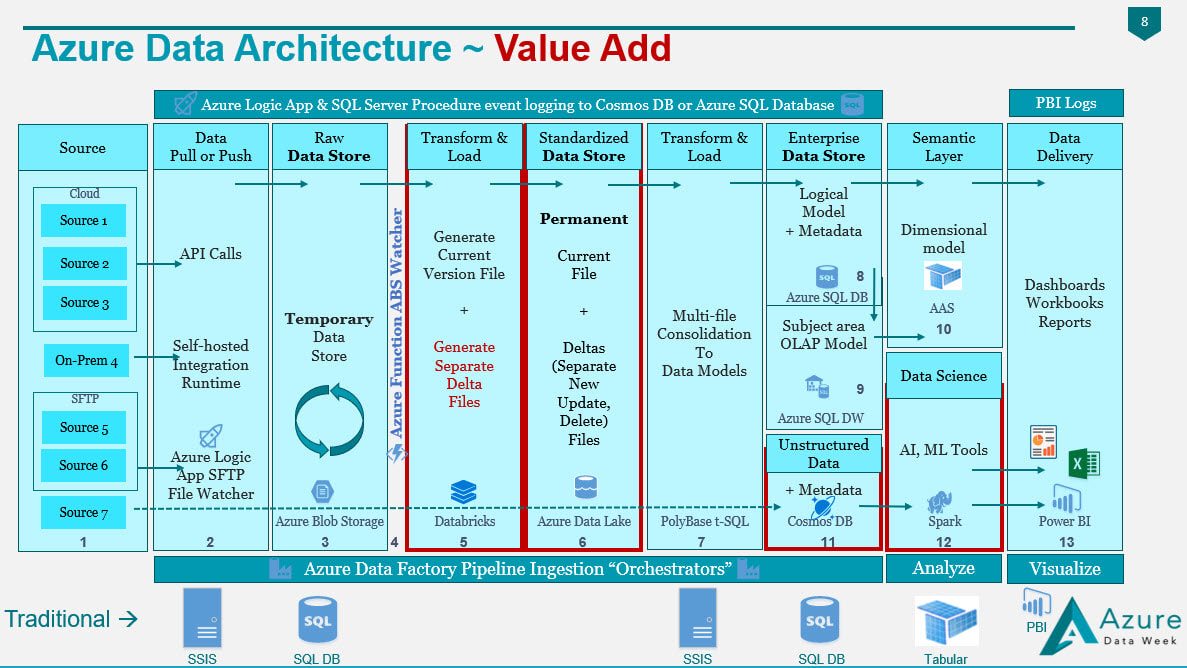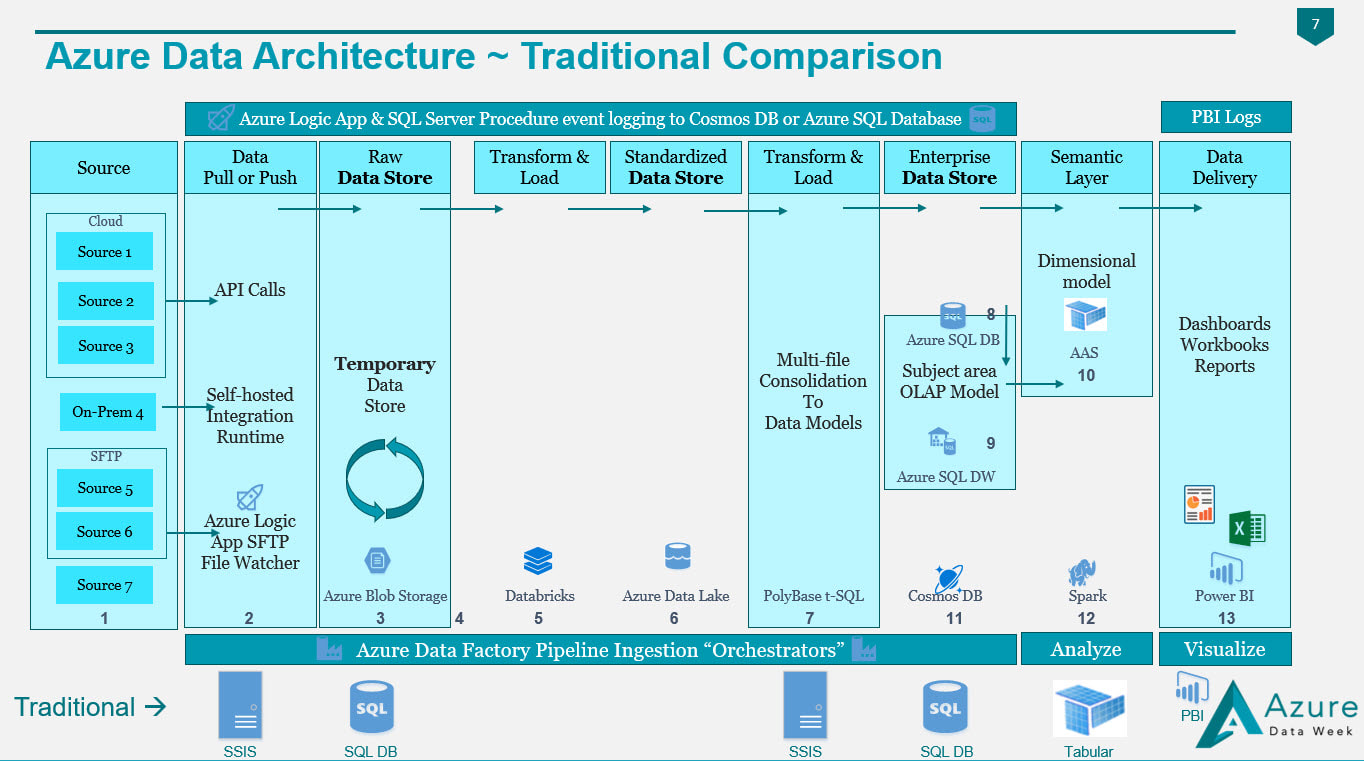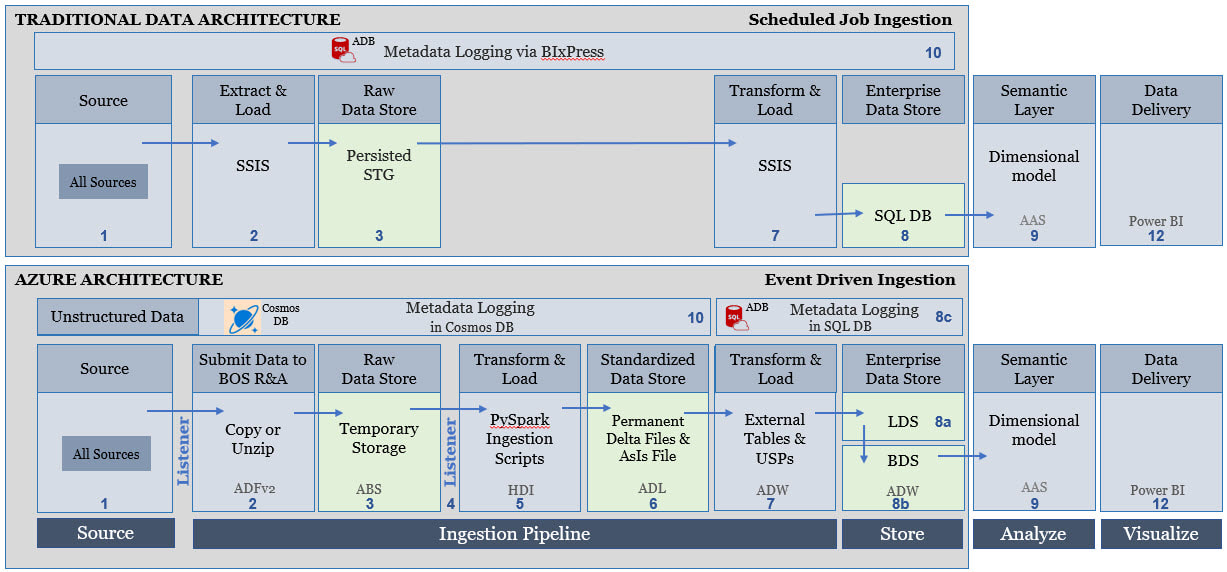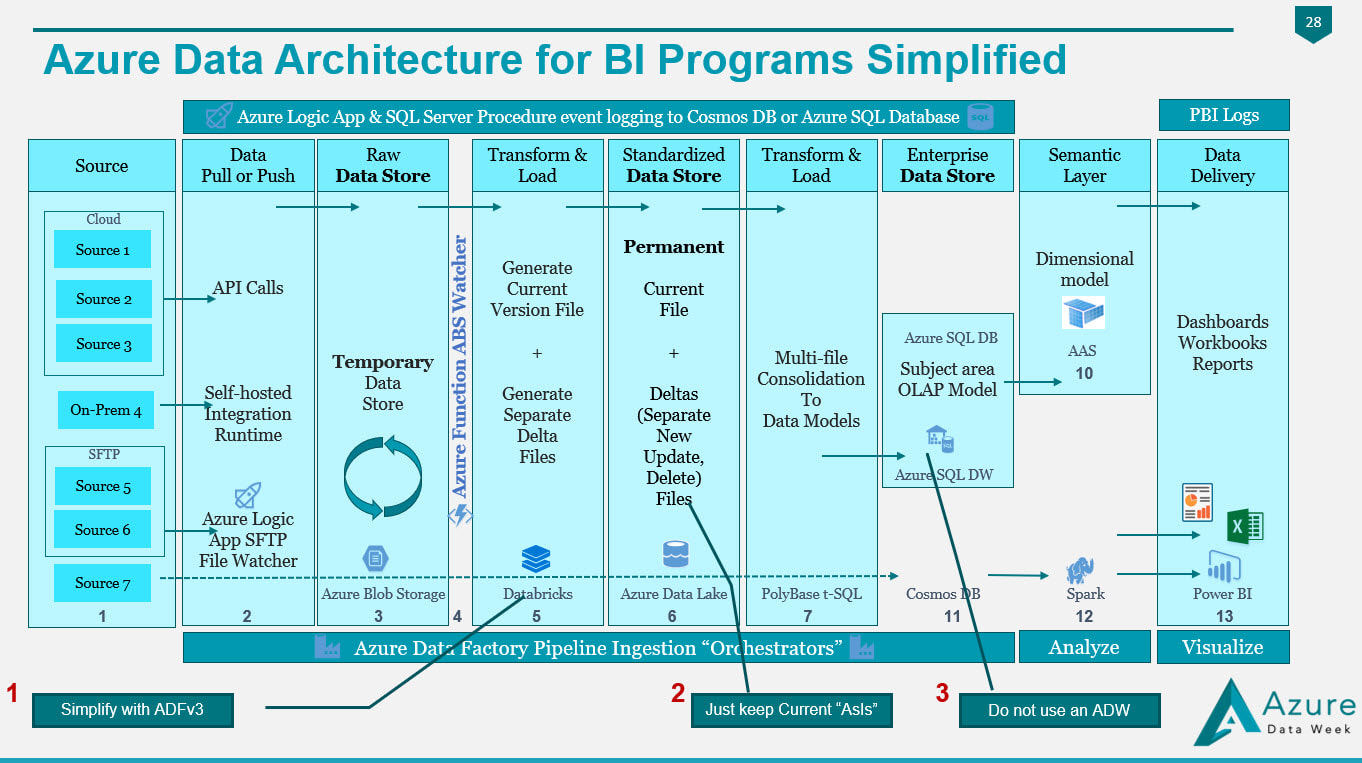Azure,
SSIS,
HDInsight,
Azure Data Factory,
Business Intelligence,
Azure Databricks,
Azure Data Lake,
Azure Data Architecture
Transitioning from Traditional to Azure Data Architectures

Confession: I put a lot of subtexts in this blog post in an attempt to catch how people may be describing their move from SSIS to ADF, from SQL DBs, to SQL DWs or from scheduled to event-based data ingestion. The purpose of this post is to give you a visual picture of how our well loved "traditional" tools of on-prem SQL Databases, SSIS, SSAS and SSRS are being replaced by the Azure tool stack. If you are moving form "Traditional Microsoft" to "Azure Microsoft" and need a road map, this post is for you.
Summary of the Matter: If you only read one thing, please read this: transitioning to Azure is absolutely "doable", but do not let anyone sell you "lift and shift". Azure data architecture is a new way of thinking. Decide to think differently.
First Determine Added Value: Below are snippets from a slide deck I shared during Pragmatic Work's 2018 Azure Data Week. However, before we begin, let's have a little chat. Why in the world would anyone take on an Azure migration if their on-prem SQL database(s) and SSIS packages are humming along with optimum efficiency? The first five reasons given below are my personal favorites.
Summary of the Matter: If you only read one thing, please read this: transitioning to Azure is absolutely "doable", but do not let anyone sell you "lift and shift". Azure data architecture is a new way of thinking. Decide to think differently.
First Determine Added Value: Below are snippets from a slide deck I shared during Pragmatic Work's 2018 Azure Data Week. However, before we begin, let's have a little chat. Why in the world would anyone take on an Azure migration if their on-prem SQL database(s) and SSIS packages are humming along with optimum efficiency? The first five reasons given below are my personal favorites.
- Cost (scale up, scale down)
- Event Based File Ingestion
- File based history (SCD2 equivalent but in your Azure Data Lake)
- Support for Near Real Time Requirements
- Support for Unstructured Data
- Large Data Volumes
- Offset Limited Local IT Resources
- Data Science Capabilities
- Development Time to Production
- Support for large audiences
- Mobile
- Collaboration

Figure 1 - Value Added by an Azure Data Architecture
If you compare my Traditional Data Architecture diagram first posted on this blog site in 2015 and the Azure Data Architecture diagram posted in 2018, I hope that you see what makes the second superior to the first is the value add available from Azure. In both diagrams we are still moving data from "source" to "destination", but what we have with Azure is an infrastructure built for events (i.e. when a row or file is added or modified in a source), near real time data ingestion, unstructured data, and data science.
In my thinking, if Azure doesn't give us added value, then why bother. A strict 1:1 "traditional" vs "Azure" data architecture would look something like this (blue boxes only) -->
If you compare my Traditional Data Architecture diagram first posted on this blog site in 2015 and the Azure Data Architecture diagram posted in 2018, I hope that you see what makes the second superior to the first is the value add available from Azure. In both diagrams we are still moving data from "source" to "destination", but what we have with Azure is an infrastructure built for events (i.e. when a row or file is added or modified in a source), near real time data ingestion, unstructured data, and data science.
In my thinking, if Azure doesn't give us added value, then why bother. A strict 1:1 "traditional" vs "Azure" data architecture would look something like this (blue boxes only) -->

Figure 2 - Traditional Components Aligned with Azure Components
It is the "white space" showing in Figure 2 that gives us the added value for an Azure Data Architecture. A diagram that is not from Azure Data Week, but I sometime adapt to explain how to move from "traditional" to "Azure" data architectures is Figure 3. It really is the exact same story as Figure 2, but I've stacked "traditional" and "Azure" in the same diagram.
It is the "white space" showing in Figure 2 that gives us the added value for an Azure Data Architecture. A diagram that is not from Azure Data Week, but I sometime adapt to explain how to move from "traditional" to "Azure" data architectures is Figure 3. It really is the exact same story as Figure 2, but I've stacked "traditional" and "Azure" in the same diagram.

Figure 3 - Traditional Components Aligned with Azure Components (Second Perspective)
Tips for Migration: Having worked with SQL Server and data warehouses since 1999 (Microsoft tool stack specifically), I am well aware of the creative solutions to get "near real time" from a SQL Agent job into an on-prem SQL Server, or to query large data sets effectively with column store indexing. For the sake of argument, let's say that nothing is impossible in either architecture. The point I'm trying to make here, however, is rather simple:
Tips for Migration: Having worked with SQL Server and data warehouses since 1999 (Microsoft tool stack specifically), I am well aware of the creative solutions to get "near real time" from a SQL Agent job into an on-prem SQL Server, or to query large data sets effectively with column store indexing. For the sake of argument, let's say that nothing is impossible in either architecture. The point I'm trying to make here, however, is rather simple:
- Transitioning from "traditional" to "Azure" is absolutely possible, but it is very helpful to identify the value added in order to justify the effort and budget. The "sell" is what you are gaining: file-based data storage, change data capture within your Azure Data Lake, support for true unstructured data, and much (much!) better support for true data science. Be very clear on what you are gaining, because some days, you'll need to be reminded (!).
- When migrating, it is critical to see how the new architecture is replacing the old, but you DO NOT want to work your little heart out to make Azure look, feel and act like SSIS or an on-prem SQL Server data store. Consider acquiring a technical Azure lead (or fantastic consultant!) who has learned to capitalize on features of the Azure tool stack and will help your BI staff to begin thinking differently.
- Azure requires new skills, but please don't give up on your current BI staff; instead, give them a chance with Pragmatic Works training courses, both free and on demand. (Check out courses and free webinars offered here.) It frustrates me that Microsoft expects everyone to now be Python and PySpark developers, but if you bring on a consultant that builds the framework of these Databricks and HDInsight components, there is a very high probability that the t-sql and C# developers you have on staff will adapt.
- There are many 1:1 similarities, especially with the coming of (what I'll call) Azure Data Factory v3 which will offer row-level data manipulation, much like SSIS. There are also options to each of my "pipelines" (Figure 4). You need to decide what is best for your company.

Figure 4
In Figure 4, we have made the following substitutions to simplify migration:
1. We have selected Azure Data Factory version 3 to replace the Python of Databricks or the PySpark of HDInsight.
2. We have removed the change data capture files in Azure Data Lake and are keeping simple "is most recent" files.
3. Unless you have data volumes to justify a data warehouse, which should have a minimum of 1 million rows for each of its 60 partitions, go with an Azure Database! You'll avoid the many creative solutions that Azure Data Warehouse requires to offset its unsupported table features, and stored procedures limitations
Every company I work with has a different motivation for moving to Azure, and I'm surely not trying to put you into my box. The diagrams shared on my blob site change with every engagement, as no two companies have the same needs and business goals. Please allow me to encourage you to start thinking as to what your Azure Data Architecture might look like, and what your true value add talking points for a migration to Azure might be.
Moving onward and upward, my technical friend,
~Delora Bradish
p.s. If you have arrived at the blog post looking for a Database vs Data Warehouse, or Multidimensional vs Tabular discussion, those really are not Azure discussion points as much as they are data volume discussion points; consequently, I did not blog about these talking points here. Please contact me via www.pragmaticworks.com to schedule on site working sessions in either area.
1. We have selected Azure Data Factory version 3 to replace the Python of Databricks or the PySpark of HDInsight.
2. We have removed the change data capture files in Azure Data Lake and are keeping simple "is most recent" files.
3. Unless you have data volumes to justify a data warehouse, which should have a minimum of 1 million rows for each of its 60 partitions, go with an Azure Database! You'll avoid the many creative solutions that Azure Data Warehouse requires to offset its unsupported table features, and stored procedures limitations
Every company I work with has a different motivation for moving to Azure, and I'm surely not trying to put you into my box. The diagrams shared on my blob site change with every engagement, as no two companies have the same needs and business goals. Please allow me to encourage you to start thinking as to what your Azure Data Architecture might look like, and what your true value add talking points for a migration to Azure might be.
Moving onward and upward, my technical friend,
~Delora Bradish
p.s. If you have arrived at the blog post looking for a Database vs Data Warehouse, or Multidimensional vs Tabular discussion, those really are not Azure discussion points as much as they are data volume discussion points; consequently, I did not blog about these talking points here. Please contact me via www.pragmaticworks.com to schedule on site working sessions in either area.
Sign-up now and get instant access

Free Community Plan
On-demand learning
Most Recent
private training



.jpg?width=406&name=Eans%20YouTube%20Thumbnails%20(2).jpg)


-1.png)
Leave a comment